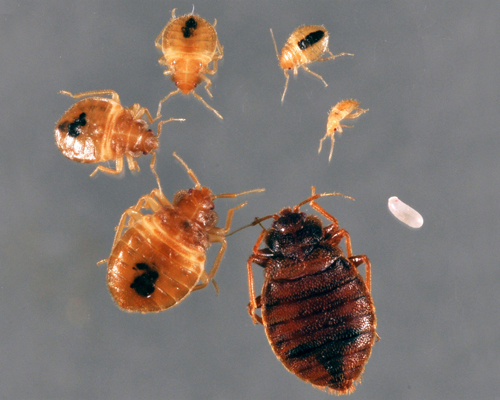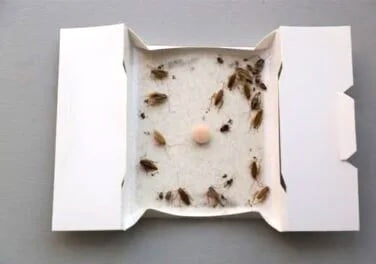To lure bed bugs into a trap, use a specialized bed bug attractant such as CO2 to mimic human breath. Place the trap near areas where bed bugs are likely to hide, such as along baseboards or under the mattress.
Bed bugs are attracted to warmth and carbon dioxide, so strategically placing traps in these areas can increase the chances of catching them. In addition to attractants, using a combination of visual cues like dark colors and textured surfaces can enhance the effectiveness of the trap.
By creating an enticing environment for bed bugs, you can increase your chances of successfully trapping them and controlling infestations in your home.

Credit: njaes.rutgers.edu
Identifying Bed Bugs
Physical Appearance
Bed bugs are small, reddish-brown insects measuring about 4-5 mm in length.
Behavioral Patterns
Bed bugs are nocturnal pests that feed on the blood of humans or animals.
Understanding Bed Bug Traps
Bed bug traps are effective tools for monitoring and trapping these pesky pests. Understanding the types of traps and how they work is essential for successful bed bug management.
Types Of Traps
- Interception Traps: Placed under furniture legs, they capture bed bugs trying to climb on or off surfaces.
- Pheromone Traps: Lure bed bugs with chemical attractants and trap them in sticky surfaces.
- CO2 Traps: Mimic human breath to attract bed bugs, then trap them in a sticky or dry environment.
How Traps Work
- Attraction: Traps use heat, pheromones, or CO2 to attract bed bugs.
- Entrapment: Once lured in, bed bugs get stuck on sticky surfaces or unable to escape.
- Monitoring: Traps help detect bed bug presence and infestation levels for effective control.
Luring Bed Bugs Into Traps
Luring bed bugs into traps is a vital part of any effective bed bug control strategy. By using the right methods to attract these pests into traps, you can significantly reduce their numbers and prevent infestations from spreading. In this guide, we will discuss the best techniques for luring bed bugs into traps, including choosing the right bait and the placement of traps.
Choosing The Right Bait
When it comes to luring bed bugs into traps, it’s essential to use the right bait. Bed bugs are attracted to carbon dioxide, body heat, and pheromones, so using a bait that mimics these signals can be highly effective. Some common effective baits include:
- CO2-producing devices
- Heat-emitting pads
- Bed bug-specific pheromones
Placement Of Traps
Placement of traps is crucial for luring bed bugs effectively. It’s essential to put traps in strategic locations where bed bugs are likely to travel, such as near the bed, along baseboards, and in areas where you have seen signs of bed bug activity. Ensure that the traps are not obstructed and are close to potential hiding spots. Additionally, consider placing traps in areas such as:
- Near the headboard of the bed
- Along the edges of the mattress and box spring
- In corners and crevices where bed bugs may hide
Monitoring And Maintenance
Regular inspection and maintenance are essential for effectively luring bed bugs into a trap. By implementing a thorough monitoring system, you can stay one step ahead of these pesky pests and protect yourself from a full-blown infestation. Here, we will discuss two crucial aspects of monitoring and maintaining bed bug traps: regular inspection and replacing traps.
Regularly inspecting your bed bug traps is the key to early detection and prevention. Make it a habit to check the traps at least once a week, paying attention to common hiding spots such as mattresses, headboards, and cracks in the walls. Start by carefully examining the traps for any signs of bed bugs, such as live bugs, shed exoskeletons, or dark spots of fecal matter. Be sure to use gloves for protection while performing the inspection.
To ensure the effectiveness of your bed bug traps, it is crucial to replace them regularly. Over time, the traps may become less sticky or lose their potency, making them less effective in luring bed bugs. We recommend replacing the traps every three to four months or sooner if they become visibly dirty or damaged. Additionally, if you discover a significant bed bug presence in a trap, replace it immediately to avoid the risk of escape or cross-infestation.
Regular inspection and replacing traps should be an integral part of your bed bug prevention measures. By staying vigilant and proactive in monitoring and maintaining your traps, you can significantly increase your chances of catching and eliminating bed bugs before they become a major problem. Remember, early detection is the key to a bed bug-free home!
Preventative Measures
To effectively lure bed bugs into a trap, place bait inside and near the trap to attract the insects. Implement preventative measures such as regular cleaning and vacuuming to reduce bed bug activity in your home. Use these strategies to proactively combat infestations.
Protecting your home from bed bug infestations is crucial in ensuring a peaceful and hygienic living environment. By implementing effective preventative measures, you can significantly reduce the risk of these pesky bugs infiltrating your home. Here are some proven strategies to keep bed bugs at bay:
Cleaning And Decluttering
Keeping your home clean and clutter-free is an effective way to deter bed bugs from invading your space. These tiny creatures thrive in cluttered areas, making it crucial to maintain a neat and organized living space. Here’s how you can achieve this:
- Vacuum Regularly: Vacuum your home, paying special attention to areas where bed bugs may hide, such as mattresses, sofas, and carpets.
- Wash and Dry on High Heat: Launder your bedding, linens, and clothing frequently using hot water and high-heat drying settings to eliminate any bed bugs or their eggs.
- Get Rid of Unwanted Items: Declutter your home by getting rid of items you no longer need. Consider donating or discarding old furniture, clothing, and other items that provide potential hiding spots for bed bugs.
Sealing Cracks And Crevices
Bed bugs can easily enter your home through even the tiniest cracks and crevices. By sealing these entry points, you can effectively prevent bed bug infestations. Follow these steps to seal potential hiding spots:
- Identify the Cracks: Inspect your home for any cracks or crevices, paying attention to areas near baseboards, electrical outlets, and furniture.
- Seal with Caulk: Use a high-quality caulk to seal any cracks or crevices you find. Pay close attention to areas where different materials meet, as these are common entry points for bed bugs.
- Repair Any Damaged Areas: Fix any damaged walls or furniture, as these can serve as potential hiding spots for bed bugs.
- Install Door Sweeps: Install door sweeps on exterior doors to eliminate gaps that may facilitate the entry of bed bugs.
- Use Bed Bug Interceptors: Place bed bug interceptors under the legs of your bed to trap and monitor any potential bed bug activity.
By implementing these preventative measures, you can significantly reduce the risk of a bed bug infestation in your home. Remember to stay vigilant and take immediate action if you suspect any signs of bed bugs. With proper precautions, you can create a bed bug-free environment and enjoy a peaceful and restful sleep.

Credit: www.amazon.com
Professional Pest Control
Professional Pest Control is a crucial step in effectively managing bed bug infestations. While DIY methods can provide some relief, enlisting the expertise of a pest control service can offer more comprehensive solutions to eradicate bed bugs from your home.
When To Seek Help
If the infestation is severe, or if DIY attempts have been unsuccessful, it’s time to seek professional help. Professional pest control services can efficiently identify and treat infestations, preventing further reproduction.
Choosing A Pest Control Service
When selecting a pest control service, consider their expertise in handling bed bug infestations. Look for a company with a proven track record in bed bug eradication and a comprehensive treatment plan. Ensure they use safe and environmentally friendly methods to eliminate bed bugs.

Credit: budgetbrotherstermite.com
Frequently Asked Questions Of How To Lure Bed Bugs Into A Trap?
How Do I Lure Bed Bugs Into A Trap?
To lure bed bugs into a trap, place the trap near areas where bed bugs hide, such as under the mattress or along baseboards. Use attractants like CO2 or heat to make the trap more enticing. Regularly inspect and replace the trap to ensure its effectiveness.
Conclusion
Luring bed bugs into a trap is an effective way to control infestations. By strategically placing traps in high-traffic areas and using enticing bait, you can increase the chances of capturing these pests. Remember to regularly monitor and replace the traps to maintain their effectiveness.
Happy trapping!
Related posts:

I’m MD Tanvir, and I bring years of expertise gained from working closely with pest control companies to the forefront. My journey in the industry has inspired me to launch Bug Battler, a platform aimed at equipping people with the know-how to combat pests autonomously. Through Bug Battler, I aim to empower individuals with practical insights to tackle pest infestations effectively.

